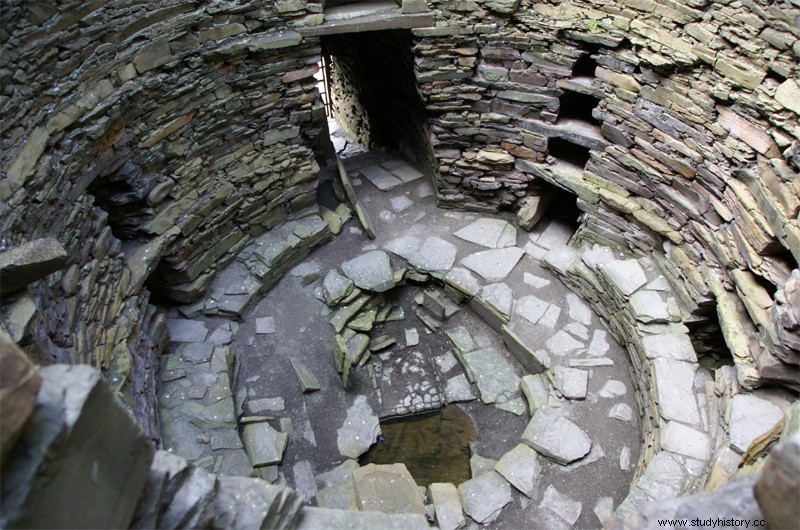The brooch Located on the small island of Mousa, in the Scottish archipelago of Shetland, it is one of the best preserved prehistoric buildings in Europe.
Not only that, of the more than 500 brochs that can be found in Scotland, this is the tallest of all, and can also be visited thanks to the repairs carried out in the 1980s.
A brooch It is a type of tower built with dry stone, without mortar, in a frustoconical shape and double walls, during the Scottish Iron Age (between 300 BC and 500 AD). These late dates may be surprising for a prehistoric period that in Europe is generally considered to have ended with the Roman conquest. But in outlying places like Scotland, it would still extend for a few more centuries.

The one in Mousa dates back to 100 BC. (300 BC according to the official Scottish heritage website), built on a small promontory on the western coast of the island of the same name in Shetland. Its location in such a remote place would explain, for archaeologists, its good state of preservation.
It is the tallest of all the brochs Scottish, with 13 meters high. Although on the contrary it is one of the smallest in diameter and interior space. Historians do not agree on its function. Some think that it had a defensive character, but others allege that, like the other brochs , it does not have openings in height, which makes it unsuitable for this purpose.
The only access to the interior is a small door at the base, and once inside, the access staircase to the upper part is complete. It is believed that originally it could have had a second floor with a wooden floor and functioned as a home, since there are remains of a fireplace and a water tank at the base.

The brooch it witnessed the Viking invasions, which could have occupied it semi-permanently. An indication of this would be that the height of the door was doubled at some point, removing the old lintels, to allow the passage of the Norse, taller than its original occupants. During the modern restoration, the entrance was lowered to its original level.
A feature that intrigues scholars is the presence on the ground floor of three compartments between the walls, which are accessed through lintel openings located half a meter from the ground. Above the lintels there are other openings that allow the passage of light and air into the chambers. Inside, each room has several shelves carved into the wall, possibly to store products or other objects. The usefulness of these cameras, like the one in the upper part of the building, has also not been determined.
What is known is that the use of the broch It was not interrupted throughout the centuries, because it is mentioned in two Viking sagas. The first, Egil Skallagrímson's saga written in the early 13th century, tells the story of a Norwegian nobleman who used it as a refuge after being shipwrecked on his journey to Iceland. The second, the Orkneyinga saga written around 1200, recounts an attack and siege on the broch by Count Harald Maddadsson, Jarl of Orkney, in 1153, to free his kidnapped mother held inside.

Interest in the building in more modern times stems from drawings made by antiquarian George Low in 1774, at a time when medieval historicism was beginning to come into fashion. This caused numerous intellectuals and writers to visit it over the following years, as was the case of Walter Scott, who in 1814 described it as a Pictish fortress, probably the most complete in the world .
The first repair and reconstruction works would arrive in 1861, finding in its interior abundant animal bones, ceramic pieces and even a Norwegian ship carved in fir wood, almost a meter long. Most of these objects are kept in the National Museum of Scotland in Edinburgh.
In 1981 Noel Fojut published a controversial article in which under the title Is Mousa a broch? questioned his ascription to said typology, based on what, according to him, anomalies that the building presents with respect to other brochs .
